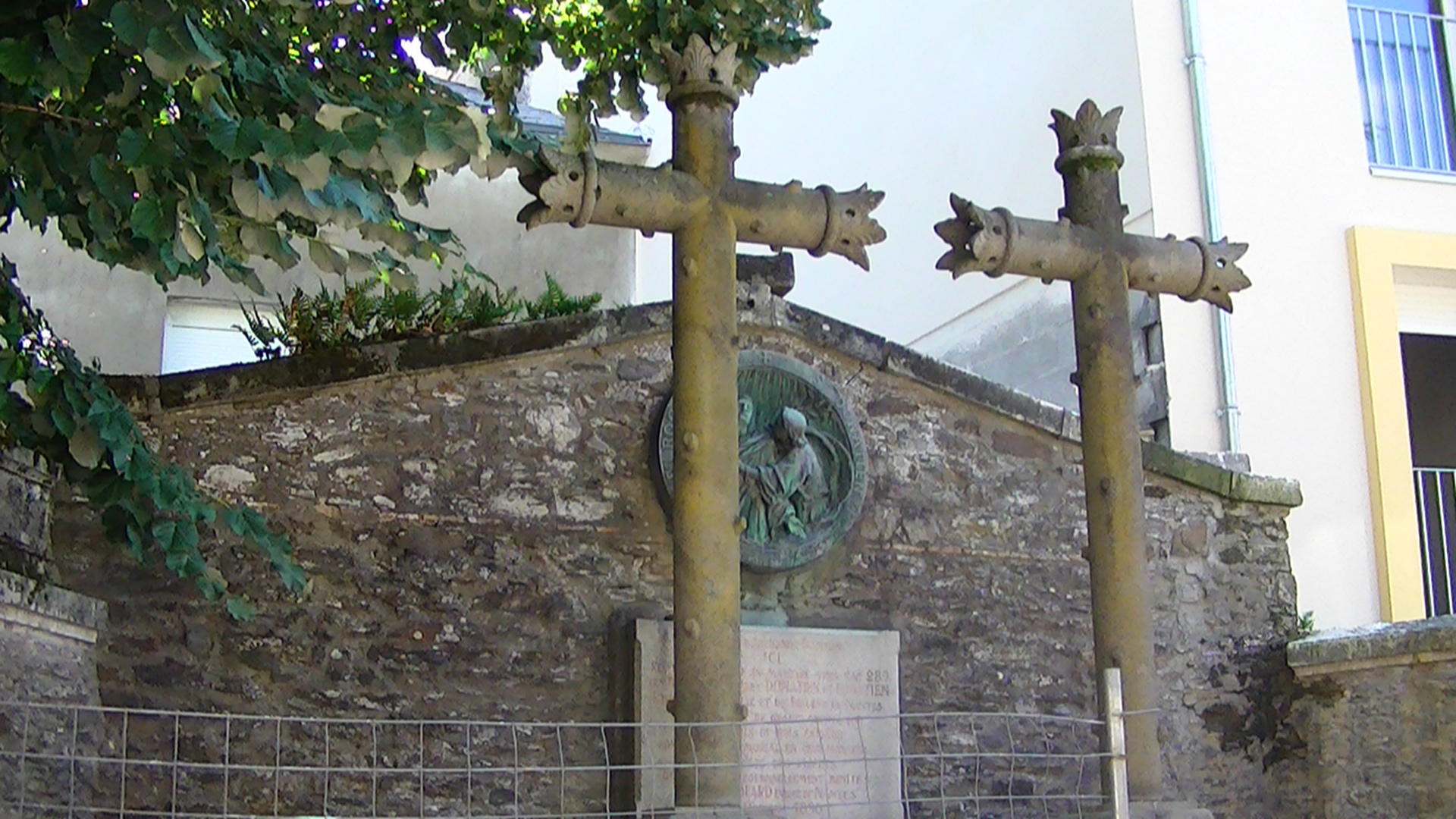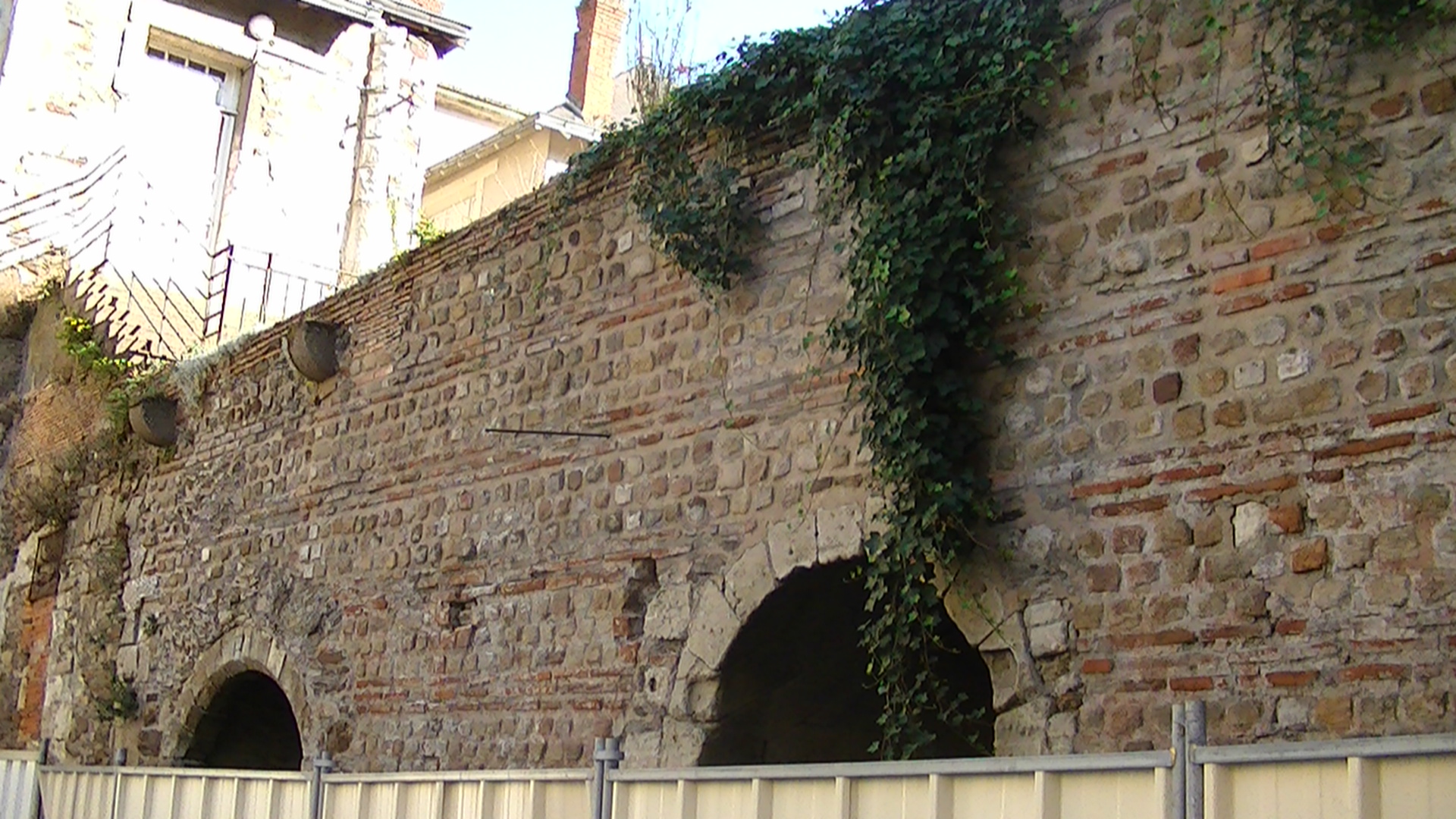It's about 2 kilometres northwest of the old city. Around the same time that the walls were built in the 3rd century, there was a Roman villa here. It was probably the home of the local Gallo-Roman magistrate, who was, according to tradition, the father of the first two Christian martyrs in Nantes, Donatian and Rogatian.
Christianity was new to Nantes. The first bishop, St. Clair, was also supposedly appointed around the late 3rd century. According to the story, Donatian was converted and baptised around the year 300 by the bishop (maybe St. Clair). Donatian introduced his elder brother Rogatian to Christianity as well, but because Christians were still being persecuted throughout the Empire at the time, the bishop fled and Rogatian could not be baptised. Both brothers were arrested, tortured, and sentenced to death by the governor of Gaul when they refused to worship the Roman gods.
 There really were Roman persecutions and many Christians were killed, but I don't know whether Donatian and Rogatian actually existed. It was popular for European cities to claim an association with Christianity dating back before the Roman Empire was officially Christianized in the 4th century. I always thought their names gave them away: "Donatianus" is the one who has already been given baptism (from the Latin "donare", "to give"), and "Rogatianus" is the one seeking baptism (from "rogare", "to ask"). I don't know how likely this is, but I would assume they replaced a local worship of the Roman twin gods Castor and Pollux. Donatian and Rogatian were supposed to have been martyred on May 24, which is also approximately the beginning of the astrological sign of Gemini, i.e. Castor and Pollux. But whether they were real or not, it was only a few years later that persecutions of Christians ended, and Christianity became the official religion of the Empire.
There really were Roman persecutions and many Christians were killed, but I don't know whether Donatian and Rogatian actually existed. It was popular for European cities to claim an association with Christianity dating back before the Roman Empire was officially Christianized in the 4th century. I always thought their names gave them away: "Donatianus" is the one who has already been given baptism (from the Latin "donare", "to give"), and "Rogatianus" is the one seeking baptism (from "rogare", "to ask"). I don't know how likely this is, but I would assume they replaced a local worship of the Roman twin gods Castor and Pollux. Donatian and Rogatian were supposed to have been martyred on May 24, which is also approximately the beginning of the astrological sign of Gemini, i.e. Castor and Pollux. But whether they were real or not, it was only a few years later that persecutions of Christians ended, and Christianity became the official religion of the Empire.The brothers are the patron saints of Nantes and they are commemorated in several places. For example, on the road between the cathedral and their namesake basilica, there is a monument at the spot where they are traditionally supposed to have been martyred (above, 63, rue Dufour). Two granite crosses were set up there in the 19th century, replacing wooden crosses that had been there since "time immemorial", according to the plaque.
| South wall. |
Chapelle Saint-Étienne
Location: Cimitière Saint-Donatien (47°13′45″N, 1°32′30″W).Donatian and Rogatian were supposed to have been buried on the grounds of their family's villa, and the first church on the spot where the current Basilique St-Donatien et St-Rogatien now stands was constructed around their tomb in the 4th century. In the cemetery of that church, a chapel was built, probably in the 6th century. This is the oldest religious building (and cemetery) in Nantes in continuous use. The city promotes the chapel as the oldest construction of any kind in Nantes, although the Roman wall is actually older. But unlike the wall, it is largely intact and easily accessible.
| Detail of the north wall. |
It's not quite a true Roman chapel, because it was built several hundred years after the wall, during the Merovingian era. The Empire was already beginning to collapse when the wall was built at the end of the 3rd century, and over the next few centuries, this part of the country was settled by different peoples from other parts of the Empire, or from outside of it. Brittany is named after Celtic tribes from Britain, who were probably escaping from the Germanic invasions of the island (such as the Angles, after whom England is named). Other Germanic tribes also invaded and settled in Gaul. They generally called themselves Franks, which is why the country is now called France. By the 5th century, one Frankish tribe, the Merovingians, ruled most of Roman Gaul, including Nantes (but not the rest of Brittany). As I mentioned in the last post, there was a Merovingian cemetery outside the Roman wall, beside the cathedral.
There were still Roman citizens in France who could build things in the old Roman style, such as this chapel. The small squared stones and layers of thinner red bricks that are obvious signs of Roman masonry are also evident in the chapel, but here, they are a bit different. The stones and the bricks just aren't as skillfully constructed. Maybe by this point, they had lost some of the knowledge and skills used to build the earlier wall. Or, as often happens with the Merovingians, they attempted to copy something Roman but they couldn't get it exactly right.
 |
| Reconstructed interior. |
Over the centuries the chapel has been modified. The east wall, currently the back of the chapel, had a Gothic-style door and window cut into it in the later Middle Ages, but they have since been covered over. Other doors and windows were cut into the other walls too.
The most unusual part of the chapel is the interior. It usually isn't open, but I was able to go inside during the Journées du patrimoine in September 2012. It used to be a functional chapel, dedicated to the first Christian martyr, St. Stephen. But whatever used to be inside is long gone. In the 19th century someone attempted to restore it, based on what they imagined the inside of a Roman chapel would have looked like. There are lots of quasi-Roman geometric designs, square stones and red bricks, but it's probably nothing like the original interior.
Basilique St-Donatien et St-Rogatien
Location: 47°13′45″N, 1°32′33″W.In the fourth century, after Christianity became the official religion of the Roman Empire, but before the Chapelle St-Étienne was built, Donatian and Rogatian's tomb had become a pilgrimage site. The church that was built over top of it was destroyed in the 9th century by the Vikings, at the same time that they damaged the Roman wall, looted several other churches, and killed the bishop in the cathedral. Other churches were built and destroyed on the same spot over the next thousand years, but the current basilica was constructed in the 1870s and 1880s. The bishop of Nantes vowed to build the current structure if Nantes was spared from attack during the Franco-Prussian war in 1871. In the end, Nantes was not attacked, and the bishop kept his vow.
The exterior seems to be modelled somewhat after Notre-Dame in Paris, although on a much smaller scale. The style is partly Gothic revival and partly Romanesque revival, but like the chapel compared to the Roman wall, it's not as nice as a real Gothic church (like Notre-Dame and the cathedral in Nantes). There are 10 statues above the portal, depicting various saints, bishops, and kings. The square in front of the basilica also has a large equestrian statue of Joan of Arc.
As far as I know there's nothing left of the original church, but Donatian and Rogatian's 4th-century marble tomb is still there. Their bones are no longer inside of it, though: the relics were transferred to the cathedral in 1145, and probably destroyed during the Revolution. The interior of the basilica is a fairly typical 19th-century French church; it looks a lot like the other churches in Nantes from the same period (like the other basilica, St-Nicolas, and the churches of St-Clément and St-Similien).
 |
| Interior, facing the apse. |
Since this basilica is not a national historical site and it's not located in the heart of the old city, it's actually difficult to get inside. The cemetery is always open and the chapel is always easy to see (except the inside), but whenever I tried to visit the basilica, it was closed. I had to hang around during mass one Sunday so I could take pictures inside afterwards. It is a local historical monument though, so it was also open during the Journées du patrimoine in September 2012.
 |
| Interior, facing the portal. |
Many other places in Nantes commemorate Donatian and Rogatian. The two streets leading up to the basilica are named after them. There are statues of them in the cathedral, and they are depicted on a relief carved into a building at the corner of Rue de la Barillerie and Rue de la Paix, near the large medieval house in Place du Change.
The basilica and the chapel were a bit out of the way and I didn't go there often, but I like the sense of continuity at the site: both the chapel and the basilica were built after Germanic invasions, 1300 years apart. Like the Roman wall in the playground of the elementary school, you can see the connection between Roman and modern Nantes all in one spot.
 |
| Donatian and Rogatian's original marble tomb (the wooden top is more recent) |
 |
| The crypt, with a monument marking Donatian and Rogatian's original burial spot. |
 |
| Mosaic above the portal. |
 |
| Detail of the statues. |
 |
| Joan of Arc statue. |
 |
| Statue of St. Donatian in the cathedral. |
 |
| Relief of Donatian and Rogatian at Place du Change. |
| Église Saint-Donatien, Orléans |
Église Saint-Donatien, Orléans
Donatian and Rogatian were popular elsewhere along the Loire River as well, and there is a church dedicated to them in Orléans. This church dates from the 12th century, from around the same time that the relics of Donatian and Rogatien were transferred to the cathedral in Nantes. Most of the current structure is much more recent though, and it's a bit difficult to find now since there are other buildings surrounding it. I was in Orléans in May 2015, and I happened to find the church when someone who worked there was inside. It wasn't supposed to be open, so the lights weren't on and I couldn't stay to take better pictures. But I did get to stay longer than I should have - I was able to talk to the guy about Donatian and Rogatian, Nantes, and medieval architecture, and he let me take these few pictures at least.| 12th-century nave |


















